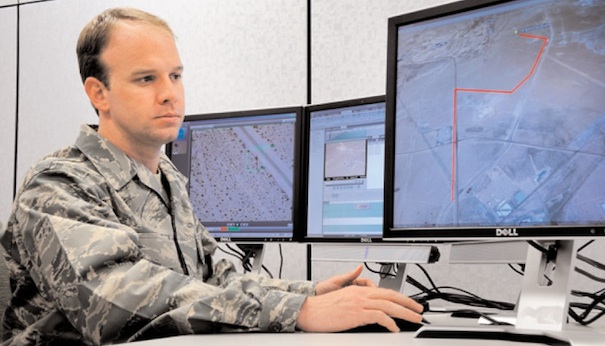Harris actualiza FAME, su motor de gestión de vídeo para entornos corporativos
Harris acaba de presentar la versión 3.1 de su solución Full-Motion Video Asset Management Engine (FAME) destinada al seguimiento de vídeo en entornos gubernamentales y centrales de inteligencia. Entre la mejoras de esta versión destacan nuevas herramientas de virtualización, un procesador VEP (video exploitation processor) y un multipantalla geoespacial.
 Harris acaba de presentar la versión 3.1 de su solución Full-Motion Video Asset Management Engine (FAME) destinada al seguimiento de vídeo en entornos gubernamentales y centrales de inteligencia. Entre la mejoras de esta versión destacan nuevas herramientas de virtualización, un procesador VEP (video exploitation processor) y un multipantalla geoespacial. La arquitectura del FAME 3.1 permitirá a las organizaciones y gobiernos aumentar la velocidad de trabajo con metadatos así como acceder desde cualquier PC a cliente basado en browser que permita acceder a toda la potencia de procesamiento del servidor FAME. El FAME 3.1 permite ingestar vídeo H.264 o MPEG-2 tanto en formatos de definición estándar como HD, recogiendo los metadatos del flujo para almacenarlos en la base del sistema de cara a acelerar la búsqueda y catalogación. Todo el material recogido es compilada bajo Motion Imagery Standards Board (MISB) incluyendo información crítica geoespacial y técnica que permirtan rápidamente localizar los clips relevantes. La consulta del material puede llevarse a cabo desde cualquier punto de la organización, obteniendo los resultados independientemente del lugar donde las imágenes se ingestaran en un principio. On the other hand, gracias al protocolo LDAP (Lightweight Directory Access Protocol), los usuarios pueden aplicar filtros para encontrar personas o grupos específicos. Los administradores pueden además aplicar filtros para permitir el acceso a ciertos usuarios a varios streams de vídeo, así como los datos creados para estos. El FAME 3.1 amplía el concepto de marcadores, que proporcionan un punto de integración de sistemas externos que producen los metadatos con referencias temporales o geoespaciales. So, un analista puede agregar los marcadores en tiempo real, mientras que el sistema que está generando otros datos de inteligencia puede utilizar la interfaz de marcador de FAME para anotar simultáneamente las imágenes. Finally, reseñar que la virtualización incorporada a la nueva versión permite compartir los recursos de un equipo físico en múltiples entornos, lo que simplifica enormemente la administración del sistema. FAME permite así la conmutación por error y técnicas avanzadas de redundancia, la reducción de la huella de hardware, reduciendo la complejidad de escalar los sistemas FAME a cientos de usuarios o streams de vídeo. Además de aumentar la eficiencia de la red al restringir la mayor parte del tráfico a un único servidor físico.
Harris acaba de presentar la versión 3.1 de su solución Full-Motion Video Asset Management Engine (FAME) destinada al seguimiento de vídeo en entornos gubernamentales y centrales de inteligencia. Entre la mejoras de esta versión destacan nuevas herramientas de virtualización, un procesador VEP (video exploitation processor) y un multipantalla geoespacial. La arquitectura del FAME 3.1 permitirá a las organizaciones y gobiernos aumentar la velocidad de trabajo con metadatos así como acceder desde cualquier PC a cliente basado en browser que permita acceder a toda la potencia de procesamiento del servidor FAME. El FAME 3.1 permite ingestar vídeo H.264 o MPEG-2 tanto en formatos de definición estándar como HD, recogiendo los metadatos del flujo para almacenarlos en la base del sistema de cara a acelerar la búsqueda y catalogación. Todo el material recogido es compilada bajo Motion Imagery Standards Board (MISB) incluyendo información crítica geoespacial y técnica que permirtan rápidamente localizar los clips relevantes. La consulta del material puede llevarse a cabo desde cualquier punto de la organización, obteniendo los resultados independientemente del lugar donde las imágenes se ingestaran en un principio. On the other hand, gracias al protocolo LDAP (Lightweight Directory Access Protocol), los usuarios pueden aplicar filtros para encontrar personas o grupos específicos. Los administradores pueden además aplicar filtros para permitir el acceso a ciertos usuarios a varios streams de vídeo, así como los datos creados para estos. El FAME 3.1 amplía el concepto de marcadores, que proporcionan un punto de integración de sistemas externos que producen los metadatos con referencias temporales o geoespaciales. So, un analista puede agregar los marcadores en tiempo real, mientras que el sistema que está generando otros datos de inteligencia puede utilizar la interfaz de marcador de FAME para anotar simultáneamente las imágenes. Finally, reseñar que la virtualización incorporada a la nueva versión permite compartir los recursos de un equipo físico en múltiples entornos, lo que simplifica enormemente la administración del sistema. FAME permite así la conmutación por error y técnicas avanzadas de redundancia, la reducción de la huella de hardware, reduciendo la complejidad de escalar los sistemas FAME a cientos de usuarios o streams de vídeo. Además de aumentar la eficiencia de la red al restringir la mayor parte del tráfico a un único servidor físico.
Did you like this article?
Subscribe to our NEWSLETTER and you won't miss anything.


